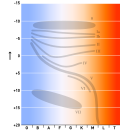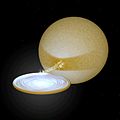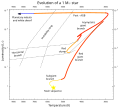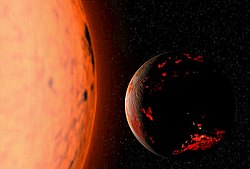A helium flash is a very brief thermal runaway nuclear fusion of large quantities of helium into carbon through the triple-alpha process in the core of...
14 KB (1,774 words) - 06:38, 7 June 2025
pressure, helium fusion will ignite on a timescale of days in a helium flash. In the nondegenerate cores of more massive stars, the ignition of helium fusion...
50 KB (6,439 words) - 09:11, 24 June 2025
called the first giant branch, is the portion of the giant branch before helium ignition occurs in the course of stellar evolution. It is a stage that follows...
32 KB (3,933 words) - 12:10, 8 June 2025
less dramatic event in the normal evolution of solar-mass stars, the "helium flash". Chemical reactions involving thermal runaway are also called thermal...
36 KB (4,173 words) - 14:00, 1 May 2025
helium core during a red giant phase, undergo a helium flash before fusing helium on the horizontal branch, evolve along the AGB while burning helium...
34 KB (4,293 words) - 21:26, 19 June 2025
up and eventually the helium shell ignites explosively, a process known as a helium shell flash. The power of the shell flash peaks at thousands of times...
26 KB (3,222 words) - 03:51, 24 June 2025
so-called helium flash. In more-massive stars, the collapsing core will reach these temperatures before it is dense enough to be degenerate, so helium fusion...
28 KB (3,497 words) - 14:13, 4 April 2025
An extreme helium star (abbreviated EHe) is a low-mass supergiant that is almost devoid of hydrogen, the most common chemical element of the Universe....
6 KB (726 words) - 20:46, 11 February 2025
lobe overflow of the primary occurs prior to helium flash, the shedding of mass can leave behind a helium white dwarf with a mass as low as 0.1 M☉. The...
3 KB (381 words) - 21:14, 9 June 2025
expands, producing an event called helium flash. Non-degenerate cores initiate fusion more smoothly, without a flash. The output of this event is absorbed...
15 KB (1,722 words) - 09:22, 1 June 2025
as their core hydrogen is depleted and they begin to burn helium in core in a helium flash; they develop a degenerate carbon-oxygen core later on the...
148 KB (16,421 words) - 22:25, 19 June 2025
-22. Deupree, Robert G.; Wallace, Richard K. (June 1, 1987). "The Core Helium Flash and Surface Abundance Anomalies". The Astrophysical Journal. 317: 724...
55 KB (2,726 words) - 06:27, 2 June 2025
to do so until it accumulates a large enough degenerate helium core to ignite the helium flash. It has likely exhausted the hydrogen from its core and...
56 KB (5,567 words) - 18:20, 23 June 2025
Nova (redirect from Helium nova)
brightest nova of this millennium, reaching magnitude 3.3. A helium nova (undergoing a helium flash) is a proposed category of nova event that lacks hydrogen...
29 KB (3,092 words) - 21:17, 18 June 2025
Triple-alpha process (redirect from Helium fusion)
process, known as the helium flash, lasts a matter of seconds but burns 60–80% of the helium in the core. During the core flash, the star's energy production...
21 KB (2,689 words) - 20:40, 2 April 2025
would probably be the one previously estimated. Once the Sun stops fusing helium in its core and ejects its layers in a planetary nebula in about 8 billion...
11 KB (1,329 words) - 01:51, 24 June 2025
the star expands so that the helium fusion ceases, and the hydrogen shell burning restarts. During these shell helium flashes, the mass loss from the star...
24 KB (2,252 words) - 13:05, 20 March 2025
believed to currently be in thermal instability and within its final shell helium flash phase. At the time of its discovery, astronomers believed Sakurai's Object...
21 KB (2,377 words) - 05:29, 18 November 2024
Intermediate polar X-ray binary Supersoft X-ray source Binary pulsar Helium flash Carbon detonation Properties Pulsating Urca process Electron-degenerate...
20 KB (2,589 words) - 23:25, 24 June 2025
but much happens. First, the core (full of degenerate helium) ignites violently in the helium flash; it is estimated that 6% of the core—itself 40% of the...
173 KB (19,378 words) - 13:02, 24 June 2025
rocks Helium fusion, a type of nuclear fusion in stars Helium flash, the sudden beginning of helium fusion in certain kinds of stars Isotopes of helium Helium-3...
2 KB (266 words) - 10:29, 10 June 2025
A helium star is a class O or B star (blue), which has extraordinarily strong helium lines and weaker than normal hydrogen lines, indicating strong stellar...
4 KB (508 words) - 02:52, 24 June 2025
stars originally similar to the Sun which have undergone a helium flash and are now fusing helium in their cores. Red clump stellar properties vary depending...
13 KB (1,733 words) - 15:54, 12 March 2025
8 times the mass of the Sun, this will occur in a process called the helium flash. The evolutionary track of the star will then carry it toward the left...
6 KB (645 words) - 10:29, 26 January 2025
sequence. After this, the star's degenerate helium core abruptly ignites in a helium flash fusing helium, and the star passes on to the horizontal branch...
12 KB (1,170 words) - 14:37, 20 March 2025
Stellar nucleosynthesis (section Helium fusion)
sufficient helium in its core to ignite it. In stars around the mass of the Sun, this begins at the tip of the red giant branch with a helium flash from a...
38 KB (4,506 words) - 12:58, 23 June 2025
Nucleosynthesis Deuterium burning Lithium burning Proton–proton chain CNO cycle Helium flash Triple-alpha process Alpha process C burning Ne burning O burning Si...
14 KB (1,695 words) - 21:03, 7 June 2025
later become a main-sequence star at the onset of hydrogen fusion producing helium. The modern picture of protostars, summarized above, was first suggested...
10 KB (1,217 words) - 03:26, 24 May 2025
to the Earth as described above. 6.6 billion The Sun may experience a helium flash, resulting in its core becoming as bright as the combined luminosity...
178 KB (7,875 words) - 02:30, 20 June 2025
temperatures. The Sun is composed primarily of the chemical elements hydrogen and helium; they account for 74.9% and 23.8%, respectively, of the mass of the Sun...
8 KB (776 words) - 11:33, 21 March 2025





















